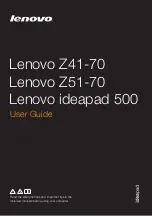
TE2300
Version
1
Last Saved on 21.05.2003 10:04
ENGLISH using TE2300_Onine.dot –– Printed on 27.05.2003 as
9
TOSHIBA TE2300
Glossary
iLINK (IEEE1394):
This port enables high-speed data transfer directly
from external devices such as digital video cameras
.
infrared port:
A cableless communications capable of using infrared
signals to send serial data.
input:
The data or instructions you provide to a computer, communication
device or other peripheral device from the keyboard or external or
internal storage devices. The data sent (or output) by the sending
computer is input for the receiving computer.
instruction:
Statements or commands that specify how to perform a
particular task.
interface:
1) Hardware and/or software components of a system used
specifically to connect one system or device to another.
2) To physically connect one system or device to another to
exchange information.
3) The point of contact between user, the computer, and the
program, for example, the keyboard or a menu.
interrupt request:
A signal that gives a component access to the
processor.
I/O:
Input/output. Refers to acceptance and transfer of data to and from a
computer.
I/O devices:
Equipment used to communicate with the computer and
transfer data to and from it.
J
jumper:
A small clip or wire that allows you to change the hardware
characteristics by electrically connecting two points of a circuit.
K
K:
Taken from the Greek word kilo, meaning 1000; often used as
equivalent to 1024, or 2 raised to the 10th power.
See also
byte
and kilobyte.
KB:
See
kilobyte.
keyboard:
An input device containing switches that are activated by
manually pressing marked keys. Each keystroke activates a switch
that transmits a specific code to the computer. For each key, the
transmitted code is, in turn, representative of the (ASCII) character
marked on the key.
kilobyte (KB):
A unit of data storage equal to 1024 bytes.
See also
byte
and megabit.










































